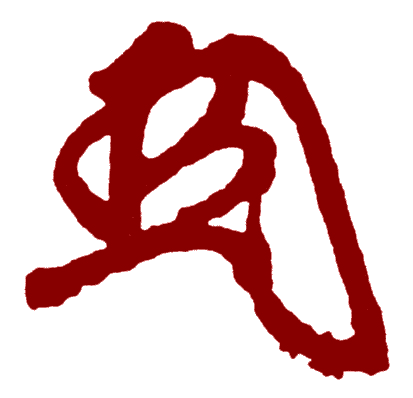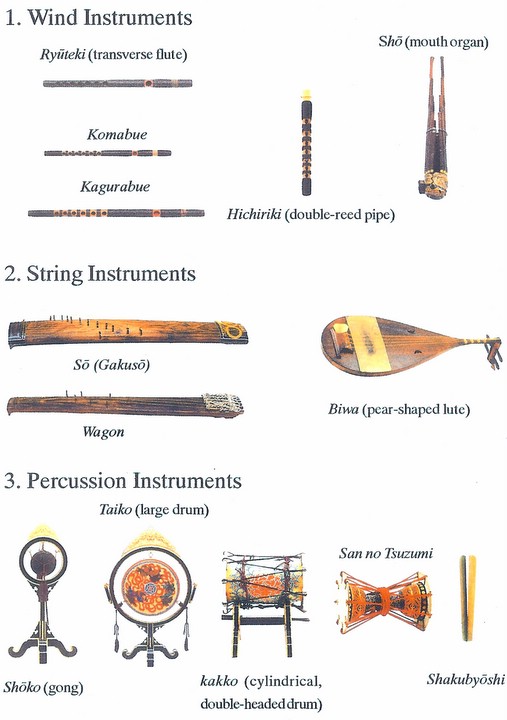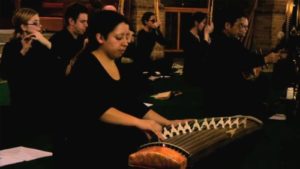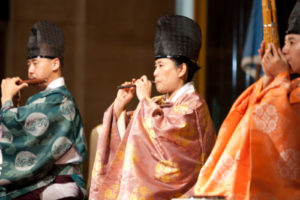Update on the Dodo Gosho Imperial Convent Archive Survey
The third session of the survey of the Hokyoji convent archives took place in August, 1995 over a four-day period. This important collection of materials collected by nuns over many centuries has been titled the Dodo Gosho bunkoafter Hokyoji convent’s informal title Dodo Gosho (the Imperial Residence Convent of Hundreds).
As was mentioned in the last issue of IMJS Reports, this survey project was begun in 1993 with the aim of cataloging all documents at monzeki or imperial convents, beginning with Hokyoji in Kyoto. It is being financed jointly by the Institute for Medieval Japanese Studies (IMJS) at Columbia University and the Kokuritsu Kokubungaku Kenkyu Shiryokan (Kokubunken) in Tokyo. The latter is paying all costs of photographing the documents (photography by Korakudo of Kyoto) and the expenses of the Kokubunken staff and tokubetsu chosa-in (survey personnel by special appointment). IMJS pays the expenses of other designated researchers, the cost of research copies of the photography for deposit in New York, the New York staff and computerizing costs. It is estimated that the entire survey will take four or five years for the Hokyoji convent alone, and many decades to come for all thirteen Imperial convents. We look forward to younger generation scholars joining forces with us for the twenty-first century historical research venture.
The participants for the current Hokyoji convent survey and their status are as follows:
ISHIKAWA Rikizan (Komazawa Daigaku) – IMJS designated researcher
KATSUURA Noriko (Tokyo Joshi Daigaku) – Kokubunken tokubetsu chosa-in
KOMINE Kazuaki (Rikkyo Daigaku) – Kokubunken tokubetsu chosa-in
LAZROVE, Anne (IMJS) – IMJS designated researcher
NAKANO Maori (Kokubunken) – staff
NISHIGUCHI Junko ( Soai Daigaku) – Kokubunken tokubetsu chosa-in
OKA Yoshiko (Otemae Joshi Daigaku) – Kokubunken tokubetsu chosa-in
RUCH, Barbara (Columbia University, IMJS) – founding director of the project
The materials have been divided into the following categories: wakanbon (bound and printed materials), nikki (diaries) and komonjo (letters and legal documents). At present the entire collection of wakanbon and most of the diaries have been catalogued. The next survey session is planned for February, 1996. It is projected that the diaries will be finished during this session. Tanaka Eko, the younger of the two nuns at Hokyoji, will also participate in the survey beginning with this session.
There has been some discussion about forming a joint study group to meet in Kyoto (kyodo kenkyukai) that will use the materials catalogued in this survey to investigate the history of nuns in the Tokugawa period. All nuns currently living in imperial convents will be invited to participate and have the opportunity to observe first-hand the benefits gained from the survey.
Original documents belonging to Hokyoji are currently in three locations: the Kyoto Hakubutsukan (Kyoto National Museum), Kyoto Daigaku Bungakubu Komonjoshitsu (Kyoto University Department of Literature Pre-Modern Documents Collection) and Hokyoji itself. When the survey of Hokyoji is completed, the Kokubunken plans to obtain microfilms of the original Hokyoji materials in the first two locations. There will then be a complete set of all known original documents from Hokyoji available for study both in Tokyo and New York.
The project will then move on to the other imperial convents in the Kyoto area. To this end, during her visit to Daishoji in October, 1995, Barbara Ruch sought and received permission from the current abbess of Daishoji, which is the highest ranking of these convents, to extend the survey to these other convents. At the same time she introduced both Nishiguchi Junko and Oka Yoshiko to the abbess so as to initiate future research visits by the team to Daishoji as well.
The current survey is the first complete survey of the Hokyoji materials. A partial survey of Hokyoji and two other imperial convents (Daishoji and Reikanji) was done in 1982 and ’83 (Showa 57 and 58) by the Kyotofu kyoikuiinkai (Kyoto Prefectural Educational Committee) led by Professor Atsuta Isao of Kobe University with Fujii Manabu of Kyoto University acting as a consultant. A catalogue of the documents was published by the Kyotofu kyoiku iinkai in 1984 under the title Ama monzeki jiin Daishoji Hokyoji Reikanji komonjo mokuroku which contains a complete listing of all the Hokyoji documents at the Kyoto Hakubutsukan and Kyoto University and a partial list of materials at the convent itself. All documents were also microfilmed and deposited with the bunkazai hogoka (cultural preservation) office of Kyoto City.
IMJS is also currently investigating ways to computerize its growing collection of primary materials on Japanese Buddhist nuns to make them more accessible to scholars. In connection with this, Patricia Fister, Associate Professor at the International Research Center for Japanese Studies in Kyoto, kindly spent a day explaining the database of Japanese art in European museums that she is helping to develop. X. Jie Yang, Associate Professor in the Department of Germanic, Slavic and East Asian Studies at the University of Calgary, Canada, and Research Associate at IMJS has also provided valuable help. Professor Yang has developed a program (known as Emaki Reader) for storing emaki or picture scrolls on CD ROM disks that allows the user to view the scroll, hear the text being read aloud, read a modern Japanese translation of the text and obtain (on the screen) detailed information on the illustrations.
-Anne Lazrove
Research Associate, IMJS
Report on Archival Collections in Japan with Materials on Monzeki Convents
In conjuction with my trip to Japan as an Institute for Medieval Japanese Studies (IMJS) designated researcher and participant in the Dodo Gosho survey, I visited several libraries and other institutions to examine their collections of materials relating to imperial convents. The following report describes the results of this research, made possible with the generous assistance of IMJS.
National Historiographical Institute
(Tokyo University)
The National Historiographical Institute at Tokyo University (Tokyo Daigaku Shiryo Hensanjo) has done multiple, but very partial surveys of imperial convents over the last century, acquiring several collections of materials from the Daishoji and Hokyoji convents as well as some individual documents from these and other convents. All are copies of the originals.
IMJS has purchased photographic reprints of the four collections listed below. Volume four of Collection I had already been microfilmed in 1988. In 1994, IMJS paid to have all remaining materials microfilmed for the National Historiographical Institute’s archives and then bought photographic reprints of all four collections.
I. Hokyoji monjo
6 vols., copied in 1887 (Meiji 20).
Call no. 3071.62-26-1~6.*
II. Hokyoji monjo
1 vol., copied in 1941 (Showa 16).
Call no. 2071.62-10.
III. Hokyoji monjo
4 vols., copied at the Kyoto Museum
in 1964 (Showa 39).
Call no. 6171.62-49-1~4.
IV. Daishoji monjo
5 vols., copied in 1984 (Showa 59).
Call no. 6171.62-150-1~5.
Collection IV was acquired in 1984 when the Historiographical Institute did a survey of Sanji Chionji, Daishoji and Jijuin, three imperial convents in Kyoto. A list of these documents was published in Tokyo daigaku shiryo hensanjo ho , vol. 20, 1985, pp. 94-96 (call no. R8500-35-20). Although the survey team visited all three convents, the list contains only documents from Sanji Chionji and Daishoji but not Jijuin (a former subtemple of the male monastery Shokokuji which is located near Hokyoji). The Historiographical Institute is now in the process of cataloguing and photographing documents at this Jijuin.
There are no complete catalogues for the other three collections as yet. However, some of the documents listed in the catalogue Ama monzeki jiin Daishoji Hokyoji Reikanji compiled by the Kyotofu kyoikuiinkai (call no. RS1071-641) are also found in collections I and III listed above. Collection II has not been catalogued at all.
The National Historiographical Institute also has the following two collections of materials:
1. Daishoji monjo
1 vol. Hand-copied in Meiji 20 (1887).
A photographic reprint is in the main
reference room.
Call no. 3071.62-182.
2. Hokyoji monjo
19 documents. Part of collection
entitledChuetsu shicho .
Call no. 7171.42-1-4-3.In addition, the following single documents are listed in the card catalogue:3. Daishoji jiki
Hand-copied in Meiji 20 (1887).
Call no. 2015-503.
4. Daishoji sedaiko
Hand-copied in Meiji 17 (1884).
Call no. 2016-582.
5. Nyodai zenji shoden
Hand-copied in Meiji 18 (1885).
Call no. 2016-307.
6. Daikankiji nai chikoin
Hand-copied in Meiji 19 (1886).
The Historiographical Institute also has a 1986 manuscript version of the book Daishoji no hikae: Kyo no ama monzeki no kikigaki nado by Taniguchi Yoko. The book was privately published in 1992 and a copy is now in the Medieval Institute archives in New York.
The Imperial Archives
Another important repository of materials on imperial convents is the Imperial Archives (Shoryobu), a branch of the Imperial Household Agency (Kunaicho). They are at present temporarily housed inside the Imperial Household Agency while a new library building is being constructed on the palace grounds. Due to the temporary quarters, a large percentage of their collection will be unavailable to researchers for the next two to three years. Anyone wishing to use these archives is advised to call ahead to get permission and find out what is available.
One document that is available is a bound volume of materials called the Ama monzeki shorui (call no. 140). This is a manuscript of various documents from imperial convents hand-copied in Taisho 12 (1923). A total of thirteen convents were surveyed including Hokyoji, Daishoji and Hojiin. This collection is a particularly rich source for the study of nuns and the Medieval Institute is in the process of acquiring a photographic copy for its archives.
In addition, the following single documents were listed in the catalogue but are unavailable for examination at the present time:
1. Keiai kaisan Shiju hongan Shomyaku shoken Nyodai osho den
Call no. 111-287.
2. Daishoji daiko Gokomatsu / Goyozei Tenno koshin furyo no uchi
Call no. 271-61.
3. Chionji sedaiko – Daishoji sedai ko wo fusu
Call no. 111-243.
4. Tsugenjishi
Call no. 111-237.
5. Tsugenjishisho
Call no. 111-141.
6. Yamashiro meisho jisha monogatari
Horyaku 7 (1757) manuscript.
Call no. 111-241.
There are several catalogues of the Imperial Archives. The original catalogue, the Wakan tosho bunrui mokuroku, was published in Showa 28 (1953). It has three volumes including the index. A one-volume supplement was published in Showa 42 (1967). Materials acquired since that time are periodically listed at the back of the Shoryobu kiyo, a research journal published by the Imperial Archives.
Other Collections
As I mentioned in the report on the Dodo Gosho survey, the Department of Literature, Kyoto University has on loan a small collection of original materials from Hokyoji called the Hokyoji monjo. Copies of these materials are also deposited at Osaka University. Other original documents belonging to Hokyoji are on loan at the Kokuritsu Kyoto Hakubutsukan (Kyoto National Museum), also mentioned above.
The Kyoto Rekishi Shiryokan (Kyoto Historical Archives) offers excellent facilities for doing research on anything relating to Kyoto. One important source of information on imperial convents in this library is the Shinnyoji monjo. Shinnyoji is an existing Rinzai branch temple of Shokokuji whose entire archives were microfilmed by the Kyoto Rekishi Shiryokan. The Medieval Institute has obtained permission to make photographic copies of these materials.
Shinnyoji was orginally a small chapel called Shomyaku’an founded by the Rinzai nun Mugai Nyodai in the late Kamakura period. It became a larger temple through the efforts of Muso Soseki in the Muromachi period and retains a stele from this period. It was revived in the Tokugawa period by a daughter of Emperor Gosai. Shinnyoji, although a temple for males, maintained close ties to the imperial convents connected with the legacy of Mugai Nyodai and held annual ceremonies in her honor. The abbesses of both Daishoji and Hokyoji are buried here. There is also a wooden statue of Mugai in the Dharma Hall that was commissioned in the Tokugawa period. Outside, underneath the alcove in which the statue is situated and visible through a small opening in the rear of the building, there is a grave marker for Mugai Nyodai. This is a relatively rare style of grave known as a byo.
Future Research
The Medieval Institute will be happy to help arrange meetings or introductions to archivists at the above mentioned collections and welcomes to our New York office contacts from scholars anywhere in the world who would like to join our efforts by doing research on these voluminous, rich resources on the history of Women and Buddhism in Japan.
-Anne Lazrove





 In conjunction with the Gagaku-Hōgaku Classical Japanese Music Curriculum and Performance Program at Columbia University, launched in September 2006, the Institute for Medieval Japanese Studies presents several public gagaku concerts and instrumental workshops to introduce the ancient music of Japan to a greater audience at Columbia University and in New York.
In conjunction with the Gagaku-Hōgaku Classical Japanese Music Curriculum and Performance Program at Columbia University, launched in September 2006, the Institute for Medieval Japanese Studies presents several public gagaku concerts and instrumental workshops to introduce the ancient music of Japan to a greater audience at Columbia University and in New York.